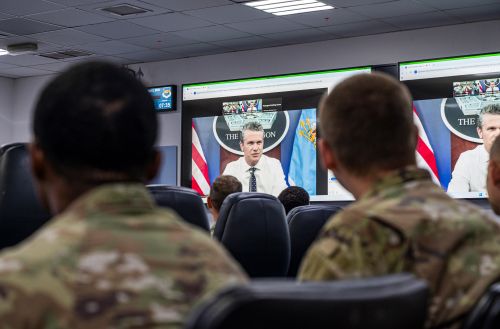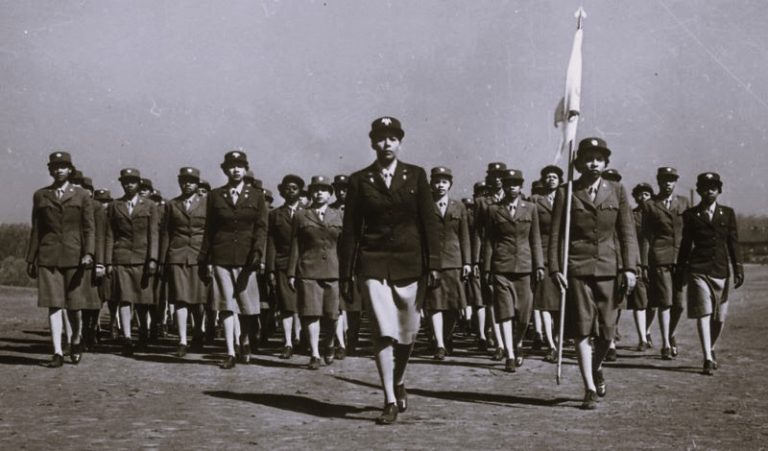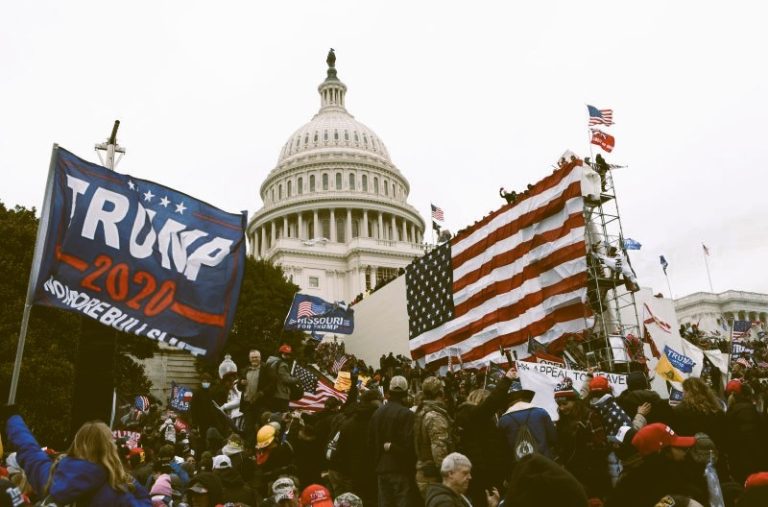

The Trump administration has already blurred lines between civilian leadership and partisan loyalty, and Hegseth’s rhetoric about “rowing in the same direction” sharpens that concern.

By Matthew A. McIntosh
Public Historian
Brewminate
Introduction
Defense Secretary Pete Hegseth has called an extraordinary conclave of America’s top generals and admirals, along with senior officers from allied militaries, at Marine Corps University in Quantico. The official explanation is that he wants to re-instill a “warrior ethos” and ensure that “everyone is rowing in the same direction.” Yet the scale, secrecy, and tone of the summons have set off alarms across Washington and beyond. Critics warn that what looks like a cultural pep talk could in fact be a loyalty test, probing whether the military brass will place allegiance to President Trump’s agenda above their sworn oath to the Constitution.
The very act of convening such a gathering recalls darker precedent, when authoritarian leaders demanded personal fealty from their armed forces. It is a reminder that in moments like this, the line between discipline and devotion can become perilously thin.
Context and Background
Pete Hegseth’s rise to the top of the Pentagon was always more about politics than policy. A former Fox News host and Iraq War veteran, he was brought into Donald Trump’s second administration as a loyalist rather than someone with significant military experience and rank and unquestioned qualification for the position. From his first day at the Department of Defense, he vowed to slash what he called “bloated bureaucracy” at the top ranks, already overseeing cuts in the number of generals and admirals in service (AP News). Hegseth has repeatedly invoked the idea of a purer “warrior culture,” railing against what he describes as “softness” in today’s military.
The planned gathering at Quantico is unprecedented. While secretaries of defense occasionally convene high-level summits, nothing on this scale (with virtually every senior officer flown in at once, plus allies looking on) has been attempted in modern memory. The secrecy surrounding the agenda has only fueled speculation. Some insiders suggest the speech will focus on grooming standards, fitness requirements, and cultural cohesion within the ranks. Others worry it could be the opening move in a broader campaign to reshape military leadership in Trump’s image.
Hegseth’s rhetoric has often blurred the line between patriotism and personal loyalty. He has echoed the president’s penchant for spectacle, most recently with the administration’s military parade down Pennsylvania Avenue. For officers steeped in the tradition of civilian control under the Constitution, the symbolism of this sudden gathering raises uncomfortable echoes of past regimes where armed forces were asked to serve not the law, but the leader.
What Is Meant by “Warrior Ethos” and “Rowing in the Same Direction”
The phrase “warrior ethos” has been a recurring theme in Hegseth’s public remarks, part cultural revival, part disciplinary crackdown. According to Pentagon officials familiar with the draft agenda, Hegseth intends to emphasize stricter grooming standards, tougher physical fitness benchmarks, and a renewed focus on what he describes as “combat readiness over bureaucracy.”
But the rhetoric of unity, “everyone rowing in the same direction,” goes beyond haircuts and push-ups. To supporters, it signals a necessary push to restore discipline and cohesion in a force they believe has been distracted by politics and social issues. To skeptics, however, the language has a more ominous undertone: the suppression of dissent within the officer corps and an expectation of ideological conformity.
The decision to record the meeting, according to insiders, suggests the administration intends to publicize at least portions of the event, framing it as a decisive moment in reshaping military culture. Yet many within the Pentagon worry about what might follow. Having already trimmed the top brass, Hegseth now wields greater leverage to pressure officers into compliance. Those who fail to “row in the same direction” could soon find themselves reassigned, retired, or simply cut loose.
Risks and Concerns
Erosion of Civil-Military Norms
The U.S. military has long prided itself on being an apolitical institution, sworn not to any one leader but to the Constitution itself. Officers are bound under the Uniform Code of Military Justice to refuse unlawful orders. Yet the optics of this gathering blur that line. By summoning the entire brass to hear a civilian appointee insist on unity, critics argue that Hegseth risks normalizing the idea that obedience to the administration takes precedence over professional judgment or legal obligation. The parallel many point to is chilling: in 1935, Nazi Germany required officers to swear personal loyalty to Adolf Hitler rather than to the German state.
Loyalty vs. Constitutional Boundaries
Every officer’s oath binds them to support and defend the Constitution against all enemies, foreign and domestic. It does not bind them to a president. Yet Hegseth’s insistence on “rowing in the same direction” raises the possibility that dissent, even on legal or constitutional grounds, could be reframed as insubordination. If the administration expects blind obedience, it risks placing commanders in the impossible position of having to choose between their oath and their careers. Many are even bracing for possible firings or demotions.
Operational and Strategic Disruption
The logistics of pulling senior commanders from their global posts at once are not trivial. Critics warn that readiness could be degraded by such a move, even briefly, while adversaries watch closely. The Washington Post has reported that some inside the Pentagon see the gathering as disruptive to chain-of-command continuity, especially given ongoing conflicts and deployments abroad.
Perception, Morale, and Insider Leverage
The message received by junior and mid-level officers will matter just as much as the one delivered to the generals. If they perceive that loyalty to Trump outweighs adherence to law, the culture of professionalism that sustains the military could erode. The meeting also risks becoming a sorting exercise: those who “get the message” and those who do not. That dynamic, observers warn, is how authoritarian leaders consolidate power, by turning institutions inward on themselves.
Possible Interpretations and Hypotheses
Overview
The sheer scale of the Quantico gathering leaves analysts divided over Hegseth’s true intentions. Some see it as pure theater, an attempt to brand himself as a reformer shaking up a stagnant military culture. Others believe the symbolism points to a deeper strategy of power consolidation.
Performative Reform Façade
To one camp, the summit is little more than a show of strength: a stage-managed event meant to portray Hegseth as decisive and Trump as firmly in control of the armed forces. From this perspective, the talk of grooming standards and “warrior ethos” is about optics, a cultural reset that plays well with Trump’s political base.
Power Consolidation
A darker interpretation is that the meeting is a prelude to restructuring, replacing or sidelining officers who resist the administration’s line. With senior ranks already thinned, Hegseth can more easily elevate loyalists and remove dissenters, a classic tactic of authoritarian regimes.
Loyalty Probe
Some insiders suggest the real purpose may be to test the waters: to gauge which officers will nod along, and which might bristle at the tone of ideological conformity. Such a litmus test could create informal “lists” of reliable allies and potential obstacles within the chain of command.
Genuine Reform Effort
There remains the possibility that Hegseth genuinely believes the military has drifted from its warrior roots, and that the meeting is aimed at refocusing on discipline, readiness, and lethality. Critics, however, question why such reforms would require convening nearly every senior officer in one room, rather than through standard policy directives. A long email or official communication would suffice.
Hybrid Approach
The likeliest explanation is likely a combination of the above: a performance for Trump’s base, a signal to allies and adversaries, a purge disguised as reform, and a subtle loyalty test, all under the banner of “rowing in the same direction.”
Reactions and Stakeholder Stakes
Inside the Military
Early whispers from the Pentagon suggest unease. Several senior officers told reporters, off the record, that they view the meeting as unnecessary at best, and coercive at worst. Even those sympathetic to Hegseth’s calls for discipline worry about the precedent: when top brass are summoned en masse to receive what sounds like a political loyalty lecture, the distinction between civilian oversight and political subservience begins to blur.
Congressional Response
Lawmakers are already circling. Democratic members of the House Armed Services Committee have called for greater transparency, warning against any attempt to politicize the military chain of command. Even some Republicans, while cautious in their language, have privately expressed discomfort. Hearings or formal inquiries may follow if evidence emerges that Hegseth’s agenda goes beyond policy into demands for personal allegiance.
Legal and Ethical Experts
Scholars of military law and civil-military relations have raised the alarm that the meeting risks undermining the principle that service members are obligated to refuse unlawful orders. Once obedience to a man begins to outweigh obedience to the law, the guardrails of democracy are already cracking.
Public Opinion and Watchdogs
Media outlets and advocacy groups have amplified the alarm, pointing to historic parallels with regimes where loyalty oaths preceded authoritarian consolidation. Watchdog organizations warn that if dissenters are sidelined, it could have a chilling effect across the officer corps, discouraging honest advice and professional candor.
Allies and Adversaries
America’s partners abroad are watching closely. For allies who depend on U.S. stability, the prospect of a politicized military leadership raises concerns about reliability. Adversaries, meanwhile, may interpret the spectacle as a sign of internal fragility, suggesting the United States is more consumed with policing loyalty within its own ranks than projecting strength abroad.
What to Watch: Key Indicators
Overview
The true meaning of Hegseth’s gathering may only become clear in the weeks that follow. Several indicators will reveal whether this was merely a cultural reset, or something more consequential.
The Speech Itself
The text of Hegseth’s remarks will be critical. Does he focus narrowly on fitness, grooming, and readiness, or does he drift into language of personal loyalty and ideological unity? Any call for allegiance beyond the Constitution will set off alarm bells.
Public Release vs. Secrecy
Pentagon officials have confirmed that the meeting will be recorded. If excerpts are released, the framing will matter: is it presented as a standard leadership pep talk, or a Trump-era show of dominance?
Personnel Fallout
Watch closely for resignations, retirements, or sudden reassignments in the weeks after the meeting. A wave of departures among officers who resist the tone would suggest the event was more than symbolic.
Congressional Oversight
Hearings, subpoenas, or oversight letters from the House or Senate Armed Services Committees could indicate serious concern within Washington that the civilian leadership is pushing into dangerous territory.
Whistleblower Leaks
Leaked memos or anonymous accounts from attendees could provide the clearest window into whether this was a cultural tightening or a loyalty test.
Future Summits
If this is the first in a series of similar gatherings, it may signal an effort to reshape the officer corps’ culture over time, embedding the Trump-Hegseth vision at every level of command.
Conclusion and Implications
On its face, Hegseth’s unprecedented gathering of the world’s top military brass could be framed as an ambitious bid to reinvigorate discipline and cohesion in the armed forces. But context matters. The Trump administration has already blurred lines between civilian leadership and partisan loyalty, and Hegseth’s rhetoric about “rowing in the same direction” sharpens that concern.
The stakes extend far beyond grooming standards or physical fitness. The legitimacy of the U.S. military has always rested on its nonpartisan character; its fidelity not to a president, but to the Constitution. If senior officers are pressured to place loyalty to a leader above the law, the foundational principle of civilian control risks being inverted.
Authoritarian regimes of the past remind us how quickly military institutions can be reshaped when leaders demand personal allegiance. Whether this meeting proves to be a symbolic show or a genuine attempt at consolidation, it represents a moment of inflection. How the generals respond – whether with silent compliance, quiet resistance, or public affirmation of their constitutional oath – may determine not only the character of the U.S. military, but the resilience of American democracy itself.
Originally published by Brewminate, 09.29.2025, under the terms of a Creative Commons Attribution-NonCommercial-NoDerivatives 4.0 International license.


